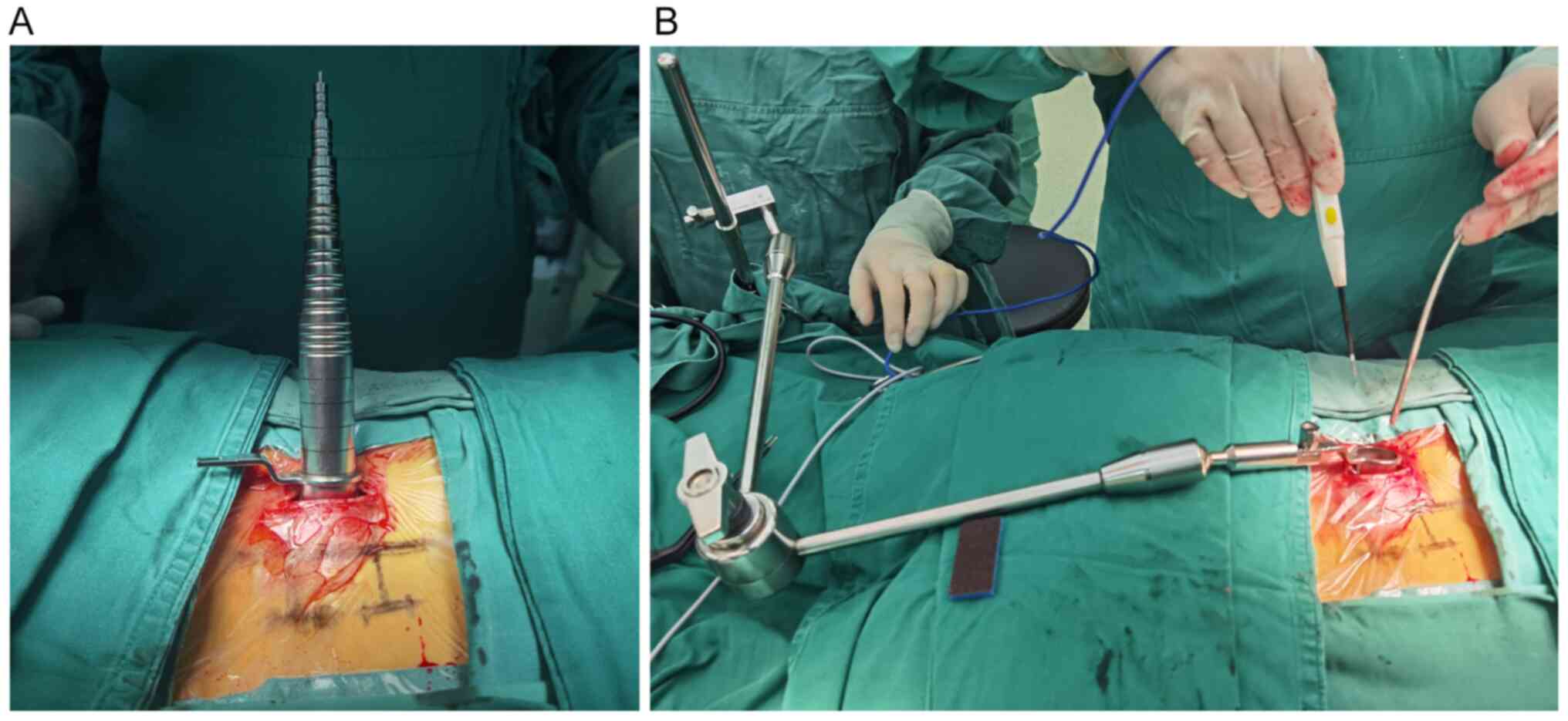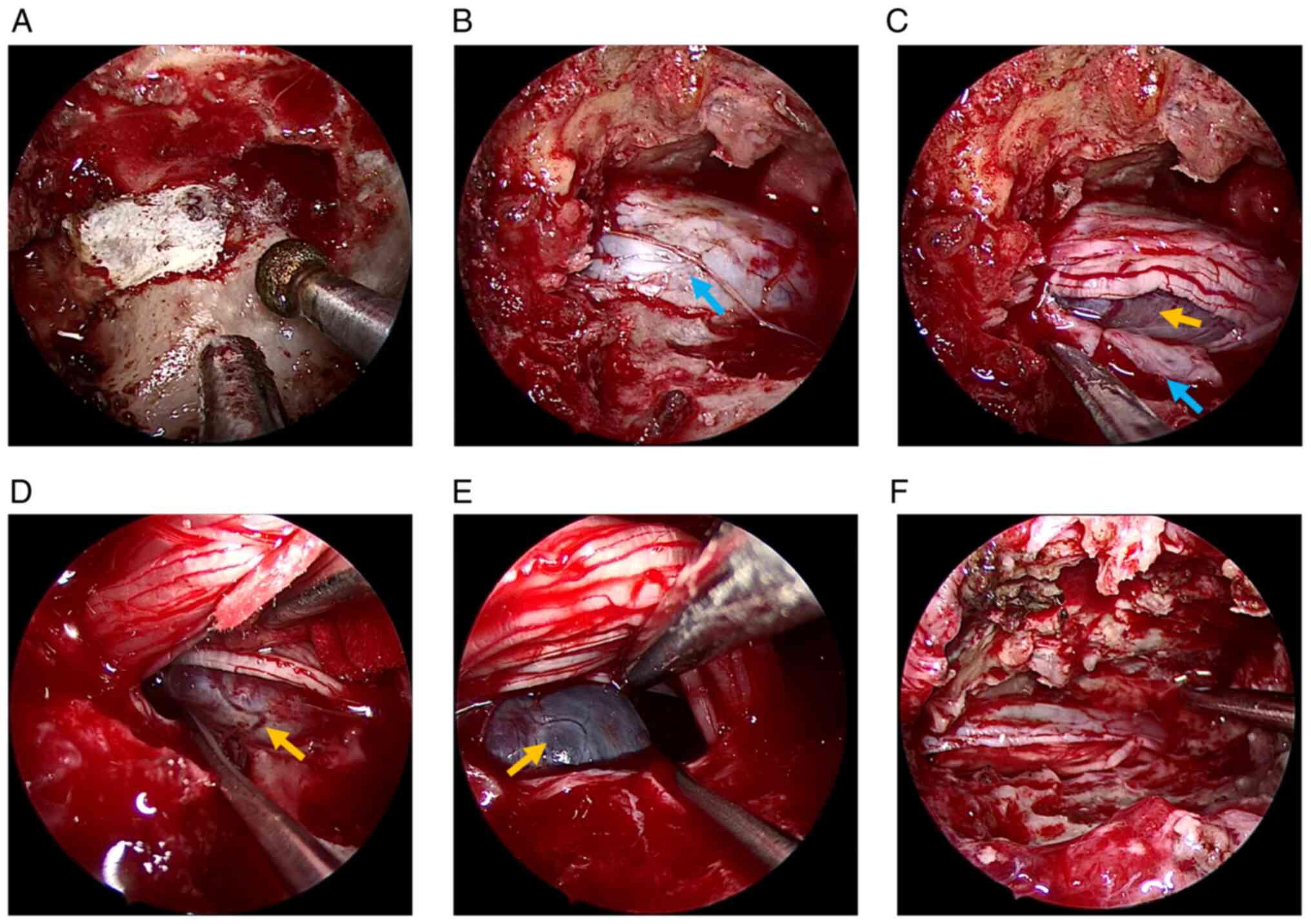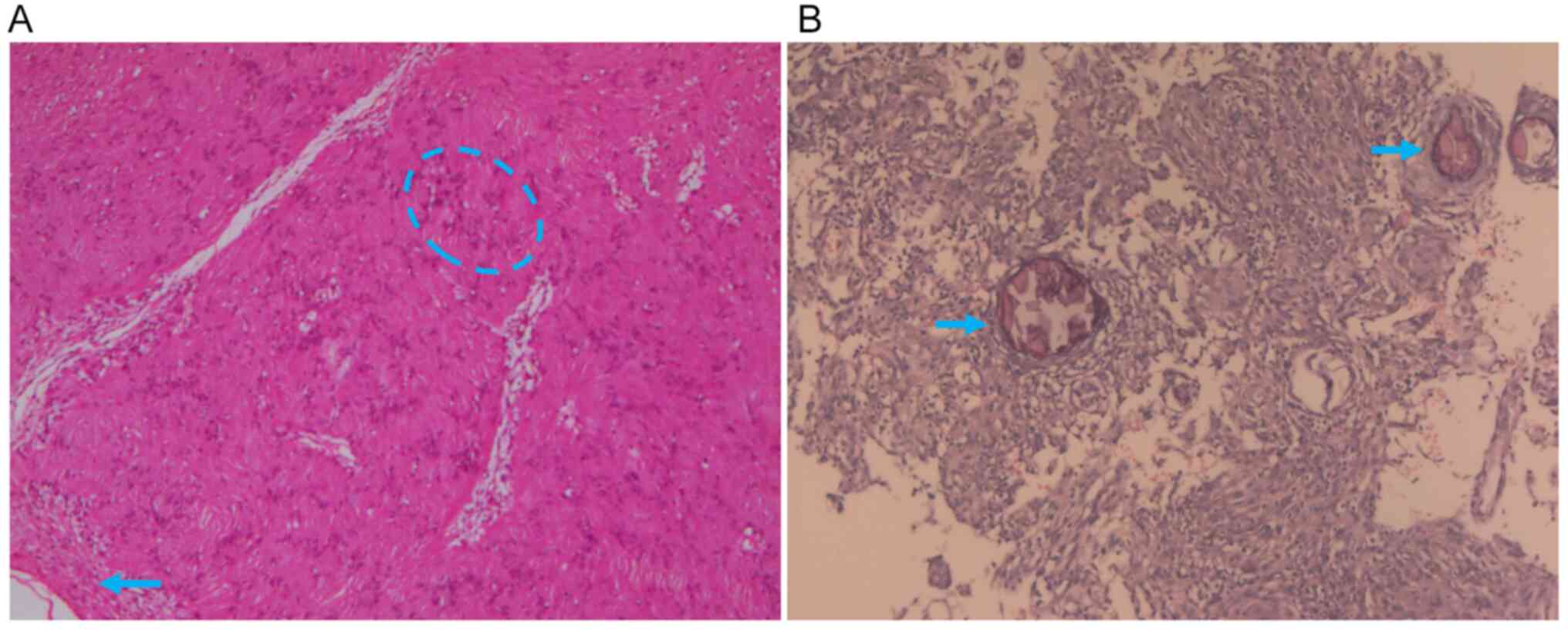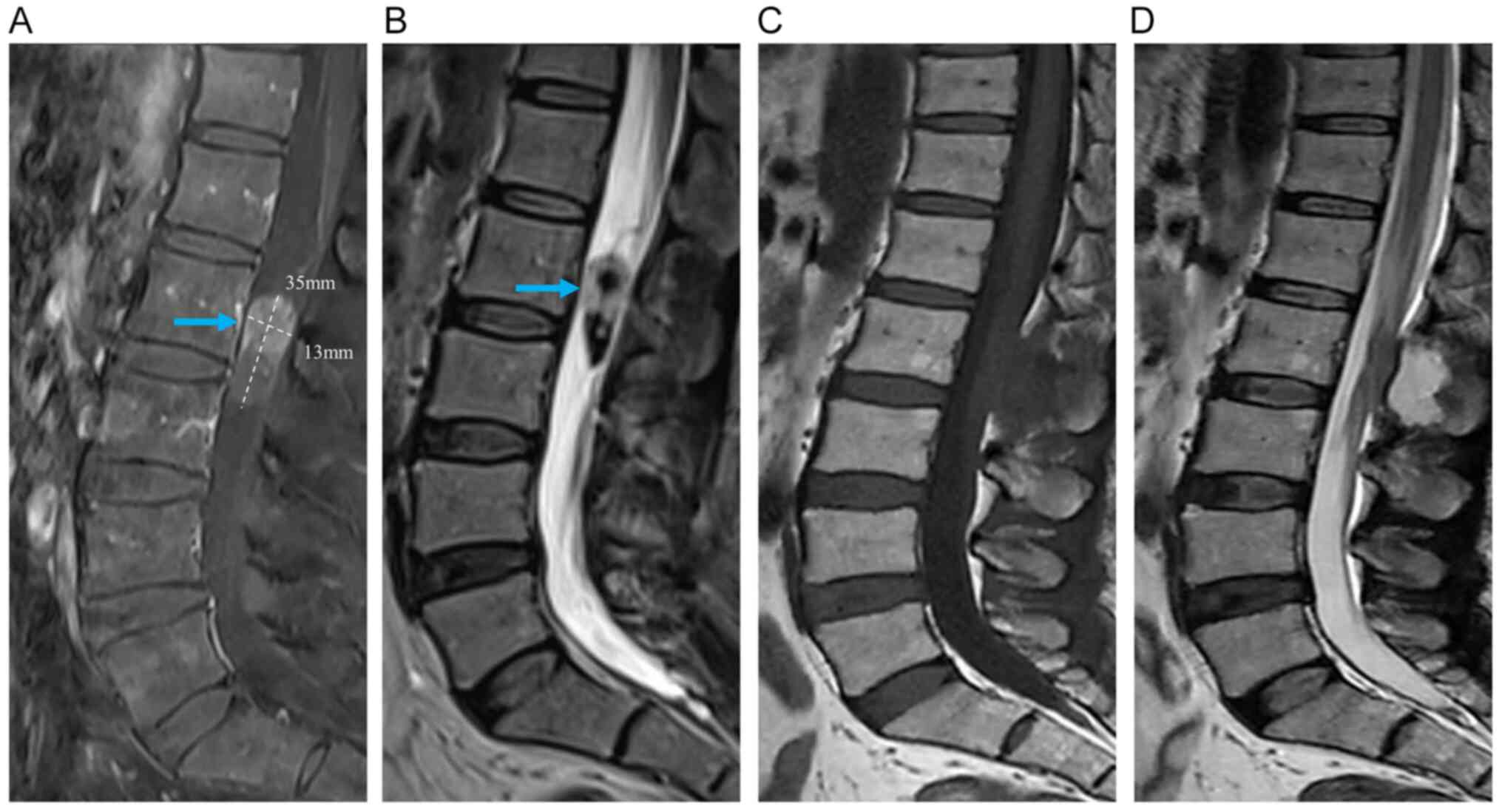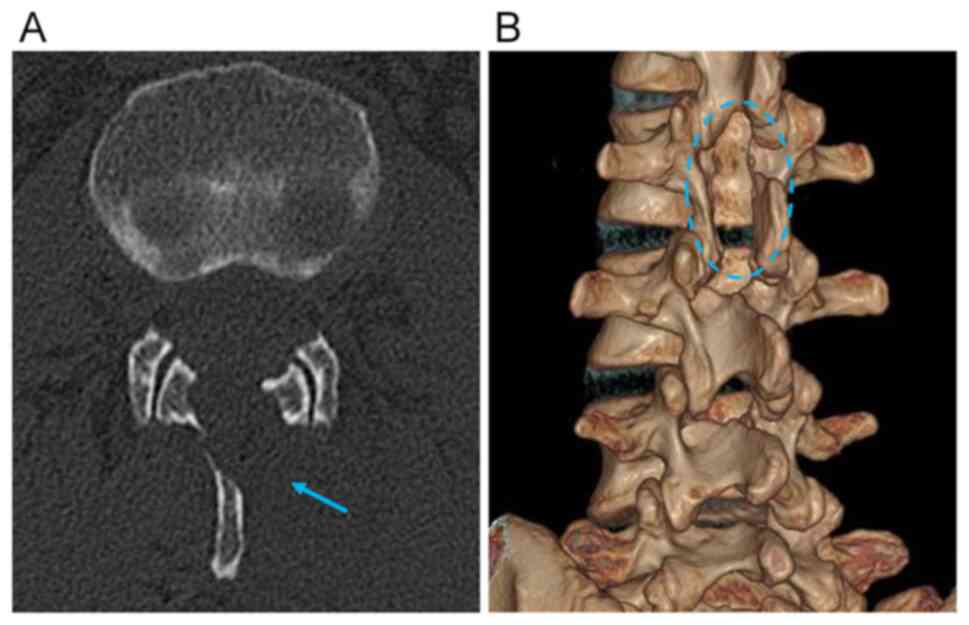Pure endoscopic minimally invasive surgery with a non‑expandable tubular retractor for intradural extramedullary spinal tumors
- Authors:
- Published online on: February 13, 2023 https://doi.org/10.3892/etm.2023.11836
- Article Number: 137
-
Copyright: © Zhang et al. This is an open access article distributed under the terms of Creative Commons Attribution License.
Abstract
Introduction
Intradural extramedullary (IDEM) spinal tumors are one of the most common intraspinal lesions that usually cause pain or neurological deficit secondary to neural compression, the majority of which are meningiomas (50%) and schwannomas (30%) (1). For such lesions, surgery is the preferred treatment, which mainly includes open spinal surgery and minimally invasive spinal surgery (MISS) (2). Generally, traditional surgery for IDEM spinal tumors uses an open approach, requiring a large incision, bilateral paravertebral muscle stripping and extensive bony resection for extensive laminectomy or additional facetectomy, which leads to the risk and probability of numerous complications, such as long-term pain, infection, cerebrospinal fluid leakage, late spinal instability or kyphosis (3,4). Given the shortcomings and limitations of the open approach, MISS emerged and gradually replaced open spinal surgery, as it has the characteristics of not damaging osseoligamentous structures and muscles, reducing the occurrence of corresponding complications to a large extent (5-7). Moreover, previous study results (postoperative efficacy and surgical complications) demonstrated that MISS is a safe and effective surgical procedure for IDEM spinal tumor treatment (8,9). In MISS, a microscope and endoscope are used as auxiliary tools to observe and distinguish lesions from normal tissues (10). In addition, to further reduce the trauma-related instability and provide operating space, tubular retractors (expandable or non-expandable) have been successfully used in MISS (11). However, to the best of our knowledge, there are few reports of pure endoscopic surgery with a non-expandable tubular retractor for IDEM spinal lesions. The present study reports 5 cases of IDEM spinal tumors that were treated by pure endoscopic MISS with a non-expandable tubular retractor, while retrospectively analyzing the procedure and outcomes of this surgical technique.
Materials and methods
Patients
A total of 5 patients with IDEM spinal tumors who underwent pure endoscopic MISS with a parallel non-expandable tubular retractor system (BeiJing Fule) were retrospectively analyzed between January 2019 and July 2020 in the Department of Neurosurgery, Chongqing General Hospital (Chongqing, China). A parallel non-expandable tubular retractor with a size of 22 mm was utilized. This could be moved 20 mm up and down by fully separating the multi-split space, meaning that the lamina could be exposed within a range of ~60 mm (~2 vertebral levels). Therefore, the IDEM tumors involving one or two vertebral levels were included in the present study, while IDEM tumors involving >2 vertebral segments were excluded. Table I shows the preoperative conditions of the cases discussed in the present report, including age, sex, tumor location, tumor size, clinical symptoms and duration of symptoms. The patients' ages ranged from 46-76 years, with an average age of 61 years, and the group included 3 men and 2 women. The preoperative evaluation consisted of clinical examination and magnetic resonance imaging (MRI) of the spine. The patients complained mainly of pain and/or neurological deficit, presenting for 3-12 months. Specifically, 2 cases only presented with a history of back pain, 2 cases presented with back pain and lower limb numbness, and 1 case presented with back pain and lower limb numbness and weakness. The preoperative MRI findings of all patients were consistent with IDEM lesions, including 2 cases in the thoracic vertebrae and 3 cases in the lumbar (L) vertebrae. According to the relationship between the spinal cord and the tumor, the tumor locations were ventrolateral (n=1), dorsal (n=1), dorsal lateral (n=1) and lateral (n=2). The tumor sizes were 35x15, 21x13, 18x7, 16x8 and 20x11 mm, respectively. Of the 5 examined tumors, 4 were within one vertebral level and 1 was within two vertebral levels. All these tumors were suitable for endoscopic surgery. The preoperative pain and neurological deficit were evaluated by the visual analog scale (12) and the modified McCormick scale (13), respectively, and indicated that the pain score was between 6 and 10, while the neurological deficit was graded as grade II in 4 cases and grade III in 1 case. Initial clinical follow-up occurred at 3 and 6 months after surgery. After 6 months of follow-up, visits were performed at yearly intervals or more frequently when indicated.
Surgical treatment
Under general anesthesia, the patient was placed in a prone position. A 1.5- to 2-cm skin incision was made 2 cm lateral to the midline, consistent with the tumor location on C-Arm. The subcutaneous tissue was dissected to the muscle fascia and paraspinal muscles, followed by blunt separation directly to the lamina from the potential space among the paraspinal muscles. Subsequently, tubular retractor devices were sequentially introduced in this space (Fig. 1A). Finally, the tubular retractor was fixed on the operating table using a flexible arm (Fig. 1B) and the appropriate position was ascertained under C-Arm, which means that its angle could be slightly adjusted to eliminate the tumor adjacent to the tube. Once the parallel non-expandable tubular retractor system was set up, the surgeon operated using an endoscope. Due to the advantages of flexible and convenient operation and ease to adjust the visualization direction at any time, hand-held endoscopes were often used to observe tumors and formulate resection plans. When the surgeon needed to perform the bimanual surgery, an assistant or a pneumatic arm held the endoscope in one corner. Thus, these methods of controlling the endoscope were used at different stages of the operation. The lamina or intervertebral space corresponding to the tumor was exposed, and the lamina corresponding to the tumor was removed with a high-speed drill and rongeur (Fig. 2A). The extent of bone resection was determined by the needs of each lesion based on the bony anatomical landmarks that were identified preoperatively and verified intraoperatively using C-Arm. The hemilaminectomy was usually applied. Exceptionally, for ventral tumors, the ipsilateral facet needs to be resected to gain space for tumor exposure. A small portion of the lower part of the ligamentum flavum was removed, exposing the dura over the mass lesion (Fig. 2B). Subsequently, the dura was opened and widened using scissors, and the lateral dura margin was contracted with 5-0 Prolene sutures to expose the tumor (Fig. 2C). The cephalic part of the tumor was loosened from the surrounding neural tissues using a dissector and the tumor was removed (Fig. 2D). After adjusting the parallel non-expandable tubular retractor angle, the caudal part of the tumor was loosened using the same aforementioned method (Fig. 2E) and the tumor was completely removed (Fig. 2F). It was noted that during the resection of lumbar meningioma, the brain cotton was used to separate the tumor from the cauda equina nerve to provide protection to the nerve. Next, the spinous process base was removed to create more space for repairing the dura. With the assistance of an endoscope, the dura mater was sutured as previously described by Parihar et al (14). If there had been a risk of cerebrospinal fluid leakage, an absorbable artificial dura mater would have been used for further dura mater watertight closure. Finally, the skin was closed with a single suture.
Pathological examination
Surgically resected tumor tissues were detected by routine pathological examination, using H&E staining. Tumor specimens were first fixed with 4% formaldehyde solution at room temperature for 24 h and then embedded and fixed in paraffin. The specimens were then cut into 4-µm sections and deparaffinized in xylene at 60˚C for 2 h. Subsequently, at room temperature, the sections were stained with 0.5% hematoxylin for 3 min, followed by 0.5% eosin for 3 min. Subsequently, the stained sections were observed under a light microscope to obtain microphotographs of the histopathology.
Results
Surgical outcomes
All patients underwent a successful pure endoscopic MISS with a parallel non-expandable tubular retractor. Table II shows the intraoperative and postoperative conditions, including blood loss, the extent of tumor resection, pathology, clinical symptoms (at 3-month follow-up), complications and follow-up time. The mean blood loss was ~47 ml, the maximum blood loss was 70 ml and the minimum blood loss was 35 ml. Postoperative MRI demonstrated that a gross total resection (GTR) had been achieved in all cases. The pathological analysis revealed schwannoma (Fig. 3A) in 3 cases and meningioma (Fig. 3B) in 2 cases. After the operation, all patients improved significantly and there were no procedure-related postoperative complications, such as cerebrospinal fluid leakage, wound hematoma or vertebral segment instability. All patients were followed up for 6-40 months, with a mean follow-up time of 25.2 months. At the initial 3-month follow-up the pain symptoms were significantly reduced or had even disappeared. The neurological status was grade I in 4 cases and grade II in 1 case; therefore, it had improved by one grade in all patients. Only one patient (case 2) still had mild lower limb weakness, which was due to the tight adhesion between the extensive basal meningioma and dura mater. However, this returned to normal in the subsequent follow-up. In the present case series, all patients achieved good outcomes without serious complications, such as long-term pain, infection, cerebrospinal fluid leakage, late spinal instability or kyphosis.
Illustrative case
A 55-year-old female patient (case 1) presented with a 6-month history of back pain and lower limb numbness. On examination, there was no weakness of the limbs and no bowel/bladder symptoms. MRI revealed an IDEM lesion at the L2-3 level (Fig. 4A and B). The patient underwent pure endoscopic MISS with a parallel non-expandable tubular retractor and postoperative imaging revealed that a GTR of all the lesions had been achieved (Fig. 4C and D). Postoperative computed tomography scans revealed laminectomy defects (Fig. 5A and B). Pathological analysis showed the Antoni B zone featuring hypocellularity in the myxoid stroma via H&E staining, which confirmed a schwannoma (Fig. 3A). Postoperatively, the patient experienced good pain relief. The patient's modified McCormick scale at 3 months improved from II to I. No spinal instability or kyphosis occurred during the follow-up.
Discussion
Due to the advantages of little tissue damage and fast recovery time, MISS for the resection of IDEM spinal tumors has been valued and favored by surgeons (15,16). The key auxiliary devices in MISS are retractors and lighting vision systems. The tubular retractor technique plays an important role in MISS and has been demonstrated to be a viable alternative to traditional laminectomy. In the study performed by Dhandapani and Karthigeyan (17), retractors were classified as non-tubular or tubular, the latter being further divided into expandable tubular and non-expandable retractors, where the non-expandable retractors could be further divided into convergent and parallel retractors. Compared with the non-tubular retractor, the tubular retractor has the advantage of less damage to surgery-related tissues while maintaining structural and functional integrity, thus it has become and has been recognized as a mainstream tool (18). Furthermore, compared with the non-expandable tubular retractor, the retraction mechanism of the expandable tubular retractor is dynamic, which may also lead to more tissue damage (18). Dahlberg et al (19) described the minimally invasive microsurgical resection of primary intradural spinal tumors using an expandable tubular retraction system. Nzokou et al (20) reported on the minimally invasive removal of thoracic and lumbar spinal tumors using a non-expandable tubular retractor. Balasubramanian et al (21) reported a large series of spinal tumors operated by the keyhole technique using a non-expandable tubular retractor. Undeniably, compared with traditional open surgery, the tubular retractor technique suffers from poor exposure of the intraspinal field. However, auxiliary lighting vision systems, such as microscopes and endoscopes, can overcome this deficiency to some extent. As for the auxiliary lighting vision systems, at present, the visualization of most MISS primarily relies on the microscope and occasionally on the endoscope (22-24). With the development of endoscopic technology, the endoscope has been widely used and recognized in neurosurgery due to its excellent intraoperative visualization. Previously, a number of cases (n≥5 per study) using MISS to treat IDEM spinal lesions have been reported and the surgical method used a pure endoscope with a retractor (as shown in Table III). Caballero-García et al (25) described the use of an endoscope and a Caspar system in MISS for IDEM spinal tumors. Similarly, Zeng et al (26) reported endoscopic MISS surgery for the removal of IDEM spinal lesions with a Williams retractor. Dhandapani and Karthigeyan (17) mainly used the X-tube and Quadrant retractor in pure endoscopic MISS to remove IDEM spinal lesions. In the aforementioned literature, the Caspar system and Williams retractor belong to the non-tubular retractor system, whereas the X-tube and Quadrangle retractor belong to the expandable tubular retractor system, which may cause uncertain damage to patients. Parihar et al (14) reported a series of cases that underwent MISS for the resection of IDEM spinal tumors using an endoscope combined with a non-expandable tubular retractor and the gross total resection of tumor has been achieved with minor blood loss in all patients. It is worth noting that the retractor used by Parihar et al (14) was a Destandau retractor system, which belongs to the convergent non-expandable tubular retractors, while the retractor used in the present study was a parallel non-expandable tubular retractor. Indeed, compared with a convergent retractor, the parallel retractor can provide more available space, making it more suitable for an endoscope and for removing larger lesions (17).
Table IIIPrevious studies (n≥5 cases per study) recording pure endoscope and retractor treatment for an intradural extramedullary spinal tumor. |
For IDEM spinal tumors, an endoscope can provide better visualization than a microscope (27). With the assistance of an adjustable angle tubular retractor, endoscopic visualization can be further expanded. Most importantly, the endoscope is allowed to enter the surgical area for close observation of panoramic visualization, which has great advantages, especially for ventral or ventrolateral lesions, in avoiding more invasive surgical approaches, such as anterior or anterolateral approaches (28,29). However, the endoscope can only provide two-dimensional images, which requires long-term training, experience accumulation and intraoperative instrument feedback to reconstruct three-dimensional (3D) images, putting forward higher requirements for surgeons (30). Although the microscope can provide 3D visualization, it is far away from the surgical area, which leads to serious light attenuation and cannot provide a close-up view of surgical details or panoramic visualization (26). These two auxiliary lighting vision systems have their advantages and limitations, and both have been proven to be effective and safe. Therefore, the choice of endoscope or microscope depends on the surgeon's preference.
Although the MISS under a microscope or an endoscope is relatively safe and effective, it is undeniable that it still has certain limitations. Soriano-Sánchez et al (31) reviewed the current indications and contraindications of microscope-assisted MISS for the treatment of IDEM lesions and considered that the key factors for the microscopic approach were tumor location, size, histology and spinal instability. For the endoscopic approach, although the tumor location is not strictly required, the tumor size is a particularly critical limiting factor. Especially for large tumors, even if expandable tubular retractors with adjustable angles and endoscopes with excellent visualization are used, it is impossible to reach all parts of the tumor, and this greatly increases the risk of bleeding and nerve damage. In general, to ensure the safety of the surgery, a pure endoscopic approach using an expandable tubular retractor is recommended for tumors within two vertebral levels (14). Hence, the endoscopy approach is indicated for no more than 2 vertebral segments. It is difficult for the endoscopic approach to remove some tumors with specific locations and histology, such as ventral meningioma (32). The ventral meningioma usually has a wide base and limited surgical space, which makes it vulnerable to spinal cord injury due to repeated traction (33). Therefore, for ventral meningioma, the endoscopic approach is not recommended, while traditional open surgery is recommended. Other ventral tumors or meningiomas at other locations (lateral, medial, or posterior) can be removed by the endoscopic approach (32). In addition, the endoscopic approach will increase the difficulty of repairing the dura mater and of achieving hemostasis (17). The bimanual technique is essential for hemostasis and the suturing of the dura. In the endoscopic approach, however, the limited available space in endoscopic surgery will increase the difficulty of using the bimanual technique, which is also a limitation of endoscopic methods (34). Furthermore, the method of using an endoscope with a non-expandable tubular retractor requires that the surgeon should have experience in both spinal surgery and endoscopic visualization.
In addition, postoperative complications are also an important concern for surgeons and patients. Tumialán et al (35) considered the correlation between the amount of bone resection and the risk of secondary spinal deformity and instability after IDEM lesion resection. Therefore, for MISS, controlling the degree of bone resection and avoiding unnecessary bone resection are key factors to minimize the risk of postoperative instability. In the present study, a hemilaminectomy was usually applied. However, for ventral tumors, the ipsilateral facet needs to be resected to gain space for tumor exposure and an additional pedicle screw fixation is required after tumor removal. Recently, Duff et al (36) reported the image merges tailored access resection technique (37) under the guidance of 3D fluoroscopy for the resection of spinal intradural lesions. In this study (36), the planned intraoperative neuronavigation was used to optimize tumor access and expose the tumor, which may further refine and reduce bone resection.
The current study reported a patient series with IDEM spinal tumors treated via pure endoscopic MISS with a parallel non-expandable tubular retractor, in which the patients achieved good outcomes. All patients improved significantly in the postoperative period and had no serious postoperative complications, which is comparable with the results of previous studies (14,17,25,26). Therefore, pure endoscopic MISS with a parallel non-expandable tubular retractor may be an effective and safe surgical strategy for IDEM spinal tumor resection. However, the present study is limited by the relatively small sample size. In further work, further cases will be recorded to increase the number of samples to further verify the surgical method.
The current study reported 5 cases of IDEM spinal tumors treated by pure endoscopic MISS with a parallel non-expandable tubular retractor, and summarized the surgical procedure and outcomes. A GTR was achieved in all cases. After the operation, all cases were significantly improved without serious postoperative complications. The results of the current series demonstrated that for IDEM spinal tumors, pure endoscopic MISS with a parallel non-expandable tubular retractor may be an effective and safe surgical strategy. Moreover, this surgical strategy has the advantage of causing low amounts of trauma, less bleeding and fewer postoperative reactions. Admittedly, despite these advantages, pure endoscopic technology has also some limitations such as the difficulty in the removal of a large tumor and a steep learning curve.
Acknowledgements
Not applicable.
Funding
Funding: No funding was received.
Availability of data and materials
The datasets used and/or analyzed during the present study are available from the corresponding author on reasonable request.
Authors' contributions
GZ, BJ, PW, CX, HJ, JL, CT, XT and NW participated in the conception and design of the study and data acquisition. GZ participated in drafting and writing the manuscript. BJ critically revised the paper. NW ensured that questions related to the integrity of any part of the work were appropriately investigated and resolved. GZ, BJ, PW, CX, HJ, JL, CT, XT and NW confirm the authenticity of all the raw data. All authors have read and approved the final manuscript.
Ethics approval and consent to participate
The Ethics Committee of Chongqing General Hospital waived the requirement for additional ethical review as this report is retrospective and not based on any specific patient priorities, experiences or preferences. Informed consent for participation in the study or use of the medical data was obtained from the patients. The patients provided permission to publish the features of their cases and the identity of the patients has been protected.
Patient consent for publication
Written informed consent was obtained from the patient for publication of this manuscript and any accompanying images.
Competing interests
The authors declare that they have no competing interests.
References
|
Ottenhausen M, Ntoulias G, Bodhinayake I, Ruppert FH, Schreiber S, Förschler A, Boockvar JA and Jödicke A: Intradural spinal tumors in adults-update on management and outcome. Neurosurg Rev. 42:371–388. 2019.PubMed/NCBI View Article : Google Scholar | |
|
Wong AP, Lall RR, Dahdaleh NS, Lawton CD, Smith ZA, Wong RH, Harvey MJ, Lam S, Koski TR and Fessler RG: Comparison of open and minimally invasive surgery for intradural-extramedullary spine tumors. Neurosurg Focus. 39(E11)2015.PubMed/NCBI View Article : Google Scholar | |
|
Lu DC, Chou D and Mummaneni PV: A comparison of mini-open and open approaches for resection of thoracolumbar intradural spinal tumors. J Neurosurg Spine. 14:758–764. 2011.PubMed/NCBI View Article : Google Scholar | |
|
McGirt MJ, Garcés-Ambrossi GL, Parker SL, Sciubba DM, Bydon A, Wolinksy JP, Gokaslan ZL, Jallo G and Witham TF: Short-term progressive spinal deformity following laminoplasty versus laminectomy for resection of intradural spinal tumors: Analysis of 238 patients. Neurosurgery. 66:1005–112. 2010.PubMed/NCBI View Article : Google Scholar | |
|
Haji FA, Cenic A, Crevier L, Murty N and Reddy K: Minimally invasive approach for the resection of spinal neoplasm. Spine (Phila Pa 1976). 36:E1018–E1026. 2011.PubMed/NCBI View Article : Google Scholar | |
|
Zong S, Zeng G, Du L, Fang Y, Gao T and Zhao J: . Treatment results in the different surgery of intradural extramedullary tumor of 122 cases. PLoS One. 9(e111495)2014.PubMed/NCBI View Article : Google Scholar | |
|
Raygor KP, Than KD, Chou D and Mummaneni PV: Comparison of minimally invasive transspinous and open approaches for thoracolumbar intradural-extramedullary spinal tumors. Neurosurg Focus. 39(E12)2015.PubMed/NCBI View Article : Google Scholar | |
|
Gandhi RH and German JW: Minimally invasive approach for the treatment of intradural spinal pathology. Neurosurg Focus. 35(E5)2013.PubMed/NCBI View Article : Google Scholar | |
|
Iacoangeli M, Gladi M, Di Rienzo A, Dobran M, Alvaro L, Nocchi N, Maria LG, Somma D, Colasanti R and Scerrati M: Minimally invasive surgery for benign intradural extramedullary spinal meningiomas: Experience of a single institution in a cohort of elderly patients and review of the literature. Clin Interv Aging. 7:557–564. 2012.PubMed/NCBI View Article : Google Scholar | |
|
Banczerowski P, Czigléczki G, Papp Z, Veres R, Rappaport HZ and Vajda J: Minimally invasive spine surgery: Systematic review. Neurosurg Rev. 38:11–26. 2015.PubMed/NCBI View Article : Google Scholar | |
|
Sharif S, Shaikh Y and Peev N: Minimally invasive spinal surgery: How to keep out of trouble. World Neurosurg. 119:517–526. 2018.PubMed/NCBI View Article : Google Scholar | |
|
Ohnhaus EE and Adler R: Methodological problems in the measurement of pain: A comparison between the verbal rating scale and the visual analogue scale. Pain. 1:379–384. 1975.PubMed/NCBI View Article : Google Scholar | |
|
McCormick PC, Torres R, Post KD and Stein BM: Intramedullary ependymoma of the spinal cord. J Neurosurg. 72:523–532. 1990.PubMed/NCBI View Article : Google Scholar | |
|
Parihar VS, Yadav N, Yadav YR, Ratre S, Bajaj J and Kher Y: Endoscopic management of spinal intradural extramedullary tumors. J Neurol Surg A Cent Eur Neurosurg. 8:219–226. 2017.PubMed/NCBI View Article : Google Scholar | |
|
Goldstein CL, Macwan K, Sundararajan K and Rampersaud YR: Perioperative outcomes and adverse events of minimally invasive versus open posterior lumbar fusion: Meta-analysis and systematic review. J Neurosurg Spine. 24:416–427. 2016.PubMed/NCBI View Article : Google Scholar | |
|
Fontes RB, Wewel JT and O'Toole JE: Perioperative cost analysis of minimally invasive vs open resection of intradural extramedullary spinal cord tumors. Neurosurgery. 78:531–539. 2016.PubMed/NCBI View Article : Google Scholar | |
|
Dhandapani S and Karthigeyan M: ‘Microendoscopic’ versus ‘pure endoscopic’ surgery for spinal intradural mass lesions: A comparative study and review. Spine J. 18:1592–1602. 2018.PubMed/NCBI View Article : Google Scholar | |
|
Wu J, Zhang C, Lu K, Li C and Zhou Y: A Novel inextensible endoscopic tube versus traditional extensible retractor system in single-level minimally invasive transforaminal lumbar interbody fusion: A prospective observation study. Pain Physician. 22:E587–E599. 2019.PubMed/NCBI | |
|
Dahlberg D, Halvorsen CM, Lied B and Helseth E: Minimally invasive microsurgical resection of primary, intradural spinal tumours using a tubular retraction system. Br J Neurosurg. 26:472–475. 2012.PubMed/NCBI View Article : Google Scholar | |
|
Nzokou A, Weil AG and Shedid D: Minimally invasive removal of thoracic and lumbar spinal tumors using a non-expandable tubular retractor. J Neurosurg Spine. 19:708–715. 2013.PubMed/NCBI View Article : Google Scholar | |
|
Balasubramanian SC, Nair AR, Saphiya NN, Madan A and Mathews SS: Minimally invasive resection of spinal tumors with tubular retractor: Case series, surgical technique, and outcome. World Neurosurg. 149:e612–e621. 2021.PubMed/NCBI View Article : Google Scholar | |
|
Zhu YJ, Ying GY, Chen AQ, Wang LL, Yu DF, Zhu LL, Ren YC, Wang C, Wu PC, Yao Y, et al: Minimally invasive removal of lumbar intradural extramedullary lesions using the interlaminar approach. Neurosurg Focus. 39(E10)2015.PubMed/NCBI View Article : Google Scholar | |
|
Mannion RJ, Nowitzke AM, Efendy J and Wood MJ: Safety and efficacy of intradural extramedullary spinal tumor removal using a minimally invasive approach. Neurosurgery. 68:208–216. 2011.PubMed/NCBI View Article : Google Scholar | |
|
Formo M, Halvorsen CM, Dahlberg D, Brommeland T, Fredø H, Hald J, Scheie D, Langmoen IA, Lied B and Helseth E: Minimally invasive microsurgical resection of primary, intradural spinal tumors is feasible and safe: A consecutive series of 83 Patients. Neurosurgery. 82:365–371. 2018.PubMed/NCBI View Article : Google Scholar | |
|
Caballero-García J, Linares-Benavides YJ, Leitão ULS, Aparicio-García C and López-Sánchez M: Minimally invasive removal of extra- and intradural spinal tumors using full endoscopic visualization. Global Spine J. 12:121–129. 2022.PubMed/NCBI View Article : Google Scholar | |
|
Zeng W, Jiang H, He S, Zhang Y, Yu B, Wang H and Wang C: Comparison of neuroendoscopic and microscopic surgery for unilateral hemilaminectomy: Experience of a single institution. Front Surg. 9(823770)2022.PubMed/NCBI View Article : Google Scholar | |
|
Ying GY, Yao Y, Shen F, Wu ZY, Chen CM and Zhu YJ: Percutaneous endoscopic removal of cervical foraminal schwannoma via interlaminar approach: A case report. Oper Neurosurg (Hagerstown). 14:1–5. 2018.PubMed/NCBI View Article : Google Scholar | |
|
Özkan N, Dammann P, Chen B, Schoemberg T, Schlamann M, Sandalcioglu IE and Sure U: Operative strategies in ventrally and ventrolaterally located spinal meningiomas and review of the literature. Neurosurg Rev. 36:611–619. 2013.PubMed/NCBI View Article : Google Scholar | |
|
Telfeian AE, Choi DB and Aghion DM: Transforaminal endoscopic surgery under local analgesia for ventral epidural thoracic spinal tumor: Case report. Clin Neurol Neurosurg. 134:1–3. 2015.PubMed/NCBI View Article : Google Scholar | |
|
Minamide A, Yoshida M, Yamada H, Nakagawa Y, Maio K, Kawai M and Iwasaki H: Clinical outcomes of microendoscopic decompression surgery for cervical myelopathy. Eur Spine J. 19:487–493. 2010.PubMed/NCBI View Article : Google Scholar | |
|
Soriano-Sánchez JA, Soto García ME, Soriano Solís S, Rodríguez García M, Trejo Huerta P, Sánchez Escandón O, Flores Soria ER and Romero-Rangel JAI: Microsurgical resection of intraspinal benign tumors using non-expansile tubular access. World Neurosurg. 133:e97–e104. 2020.PubMed/NCBI View Article : Google Scholar | |
|
El-Hajj VG, Pettersson-Segerlind J, Fletcher-Sandersjöö A, Edström E and Elmi-Terander A: Current knowledge on spinal meningiomas-surgical treatment, complications, and outcomes: A systematic review and meta-analysis (Part 2). Cancers (Basel). 14(6221)2022.PubMed/NCBI View Article : Google Scholar | |
|
Tola S, De Angelis M, Bistazzoni S, Chiaramonte C, Esposito V and Paolini S: Hemilaminectomy for spinal meningioma: A case series of 20 patients with a focus on ventral- and ventrolateral lesions. Clin Neurol Neurosurg. 148:35–41. 2016.PubMed/NCBI View Article : Google Scholar | |
|
Kravtsov MN, Manukovsky VA, Mirzametov SD, Malysheva OV, Averyanov DA and Svistov DV: Percutaneous transforaminal full-endoscopic removal of neurinoma of the fifth lumbar nerve root with intraoperative neuromonitoring: A case report. Front Surg. 9(877974)2022.PubMed/NCBI View Article : Google Scholar | |
|
Tumialán LM, Theodore N, Narayanan M, Marciano FF and Nakaji P: Anatomic basis for minimally invasive resection of intradural extramedullary lesions in thoracic spine. World Neurosurg. 109:e770–e777. 2018.PubMed/NCBI View Article : Google Scholar | |
|
Duff JM, Omoumi P, Bobinski L, Belouaer A, Plaza Wuthrich S, Zanchi F and Maduri R: Transtubular image-guided surgery for spinal intradural lesions: Techniques, results, and complications in a consecutive series of 60 patients. J Neurosurg Spine: 1-9, 2022 doi: 10.3171/2021.10.SPINE211168 (Epub ahead of print). | |
|
Maduri R, Bobinski L and Duff JM: Image merge tailored access resection (IMTAR) of spinal intradural tumors. Technical report of 13 cases. World Neurosurg. 98:594–602. 2017.PubMed/NCBI View Article : Google Scholar |



